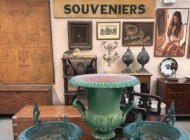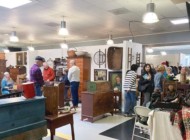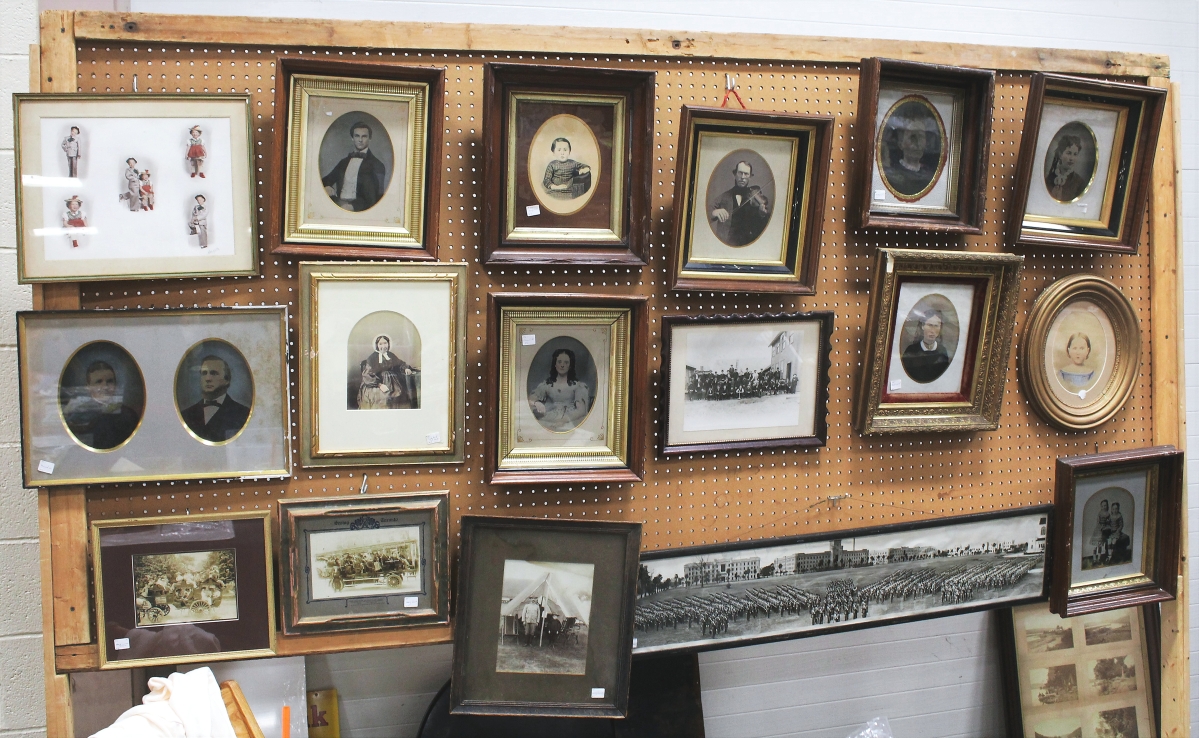
This gallery wall of portrait photographs was represented by Marti Steiner Jones and her daughter, Beth Jones, and were priced between $50 and $100. Marti is co-owner of Antiques on Elm in Manchester, N.H.
Review & Photos by Z.G. Burnett
ALLENTOWN, PENN. – For more than 50 years, the Allentown Paper Show has been one of the largest and most varied ephemera fairs in the Northeast. Beginning in 1970, the show started with general antiques and transitioned into a book, paper and ephemera show to much success, so much so that a second show was added to the calendar year. After 42 years of show running, founder Joyce Heilman retired in 2021 and brought local marketing professional and longtime Paper Show fan Sean Klutinoty to the position. On October 1, Klutinoty was at the front door of the “Ag” Hall at the Allentown Fairgrounds, bright and early at 8 am while many vendors were still setting up more than 200 booths. The venue, formally known as the Agriculture Hall, is a combined industrial structure of two giant spaces that looked anything but empty when all the merchandise was on display by 9 am when the doors opened.
“We had more than 1,000 people come through the doors,” Klutinoty said. “Many people came for both days.” The first day quickly saw the Ag Hall filled with customers, and the second day saw much more buying and selling despite a slightly smaller crowd. Dealers were still very happy with their sales and, according to Klutinoty, some said it was their best show.
Attendees were funneled into the first building and greeted by two rows containing 34 booths. An eye-catching oversized poster clamped high on the wall demanded attention. Brought by The Rock Top Book Shop and Bindery of Cashtown, Penn., the poster was a possibly unique example of advertising for Georg Jacoby’s Großalarm (1938), released in France as Chasse à l’homme and translated to English as Man Hunt. Not to be confused with Fritz Lang’s 1941 thriller, this film follows an unlucky delivery man who mistakes another’s notebook for his and becomes the target of a local gang of automobile thieves. Representing Rock Top was Mike Shoemaker of Shoemaker Booksellers (Gettysburg, Penn.), who explained that the poster had extensive water damage when it was found. It had been cleaned, restored and backed on linen to great effect, and was priced at $5,000.
Further down the aisle was an impressive photo wall of framed Nineteenth Century photographs of people whose names may be forgotten but were likely to find new families with collectors that weekend. These were presented by Antiques on Elm in Manchester, N.H., a group shop co-owned by Marti Steiner Jones, Monica Riley and Lita Hogan. Jones has been dealing and collecting antiques for 47 years and was representing the shop with her daughter Beth. After participating in April and last October, they decided that another fall show was well worth the 12-hour roundtrip tour. The photographs were priced between $50 and $100, and as customers poked holes in their display, the vacant spaces were refilled with more frames.
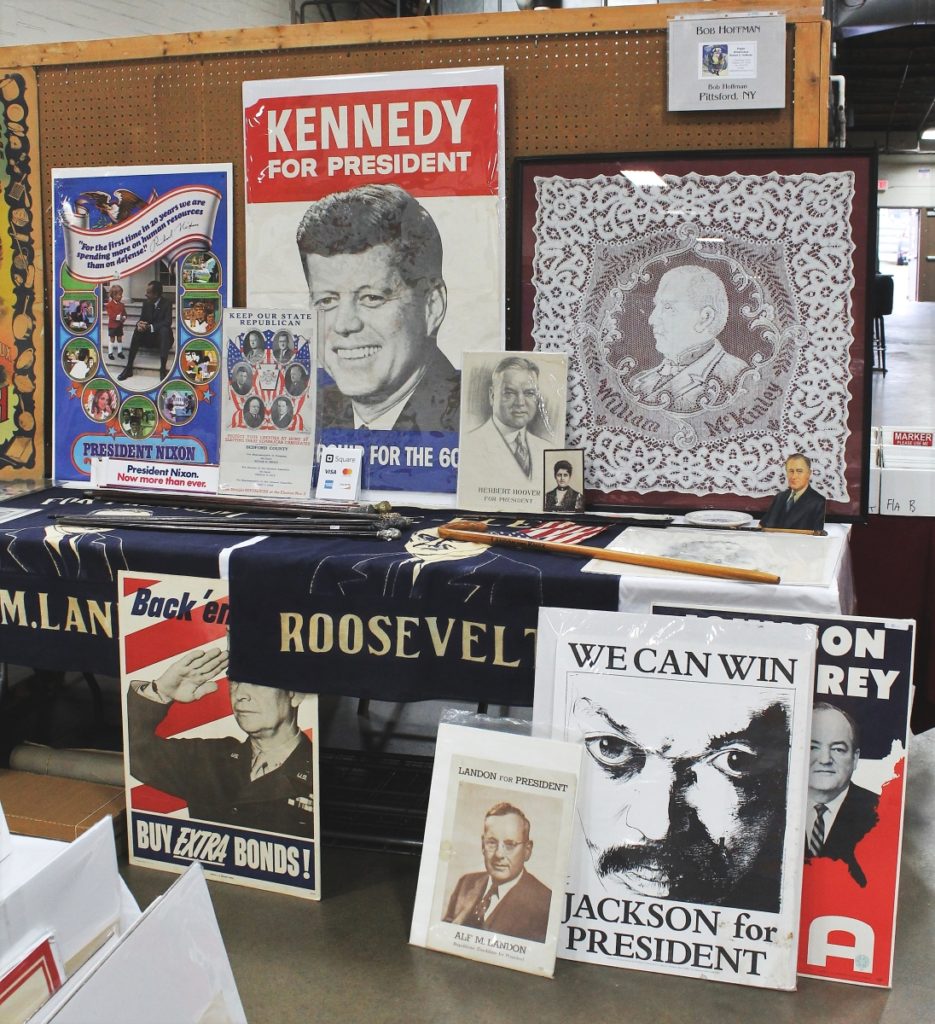
Collectors of presidential memorabilia were well-served at Allentown; this collection of campaign posters and other materials was offered by Bob Hoffman of Paper Americana, Pittsford, N.Y.
Somewhere In Time, Cincinnati, Ohio, displayed another gallery wall but instead of photographs, it was stocked with shelves of well-preserved boxes for men’s and women’s clothing, mostly for hosiery. “It’s true ephemera,” said Bette Jones, who has been selling for 20 years. “These are the sort of things that would have been thrown away, but somehow survived.” The boxes dated from around the turn of the Twentieth Century to the 1950s and were priced from $20 to $70.
Scott and Cynthia Bullock of Black Cat Antiques, Bethlehem, Penn., specialize in antique and vintage holiday goods, and their booth focused on Halloween and Christmas ephemera for the fall show. Planning ahead, the majority of their booth was devoted to Christmas and decorated with ornaments, antique greeting cards and die cuts. Most of these glittering goods were German, and Cynthia shared that they transitioned specifically into holiday items from general antiques “years ago.” Halloween was becoming particularly difficult to find, she mentioned. The die cuts were priced according to size and age, from around $50 to the low hundreds.
Sharing a booth in the Ag Hall’s even more expansive second building of more than 100 vendors was Karen Frost and Kristina Gangitino, who showed an extensive array of antique and vintage photographs, some antique children’s clothing and small accessories. Frost was selling her collection following the recent closing of her business, Isabelle’s Bridal & Eveningwear in Somerville, N.J. Many of the photographs were arranged around her booth like an antique album, and past customers may recognize those she used for the shop’s promotional materials and decorations. “It combined my two loves: antiques and bridal [clothing],” Frost explained. Reviews from Isabelle’s customers highly praise Frost’s service and expertise, which was evident in how generous she was with her time at the show.
Gangitino has always been a fan of jewelry and did not have much passed down from her family, so after modifying a ring from her grandmother into a piece she enjoyed wearing, she began making jewelry and accessories with the brand Plumes in Bloom. After meeting Frost, Gangitino began incorporating photographs into her work. “People don’t carry photographs like they used to, and I love to make old things new again,” she said. Gangitino was happy to make new contacts at the show and received a few jewelry commissions, as well. Keep an eye out for her Etsy account, currently in the works.
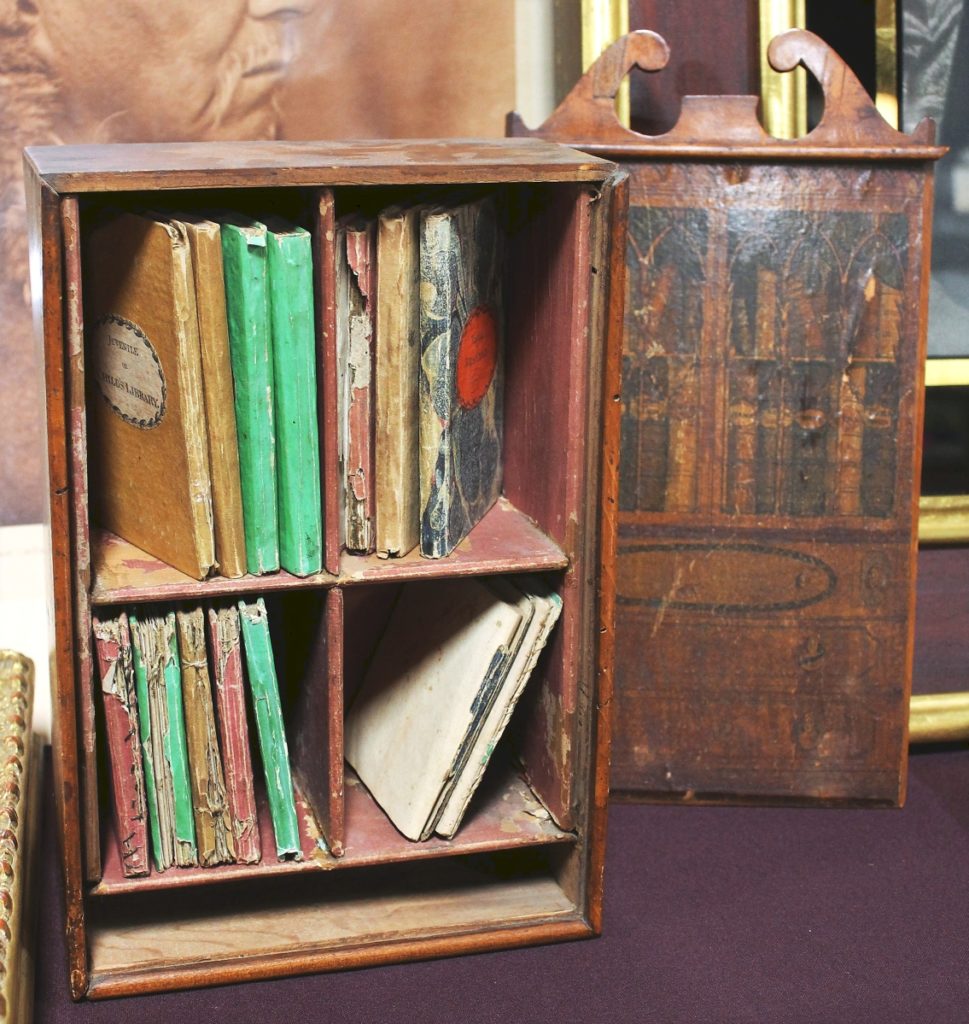
This miniature “juvenile library” was produced by John Marshall in the early Nineteenth Century and offered by Ken Leininger, Denver, Penn., who had never seen an example like this; it was offered for $2,500.
The nature of ephemera sometimes makes it difficult to find a source for objects; those who have only lived in the digital age can have trouble conceptualizing the amount of paper products that recorded everything before the advent of hard drives, and much information has been lost as collections were consolidated or discarded. Sometimes the hunt for those answers can drive a sale, along with aesthetic appreciation. This was the case with a signed painting from Bob Nance of Hazelton, Penn., who was selling an attractive jewel-tone painting of a cowboy burning his own “Wanted” poster, showing his reflection in a bullet-shattered mirror. The painting was signed, but Nance was unable to find anything about the artist. The painting was bought and sold by another dealer within the space of our conversation for $250.
Often vendors sell group lots of photos or full albums, appealing to a buyer’s interest in an established collection or archive, and to the possibility of reselling the objects therein piece by piece. Jason Denlinger of Denver, Penn., went the extra hundred miles in this regard, offering the entire studio archive of photographer Henry M. Beach (American, 1863-1943). Best known for his photography of the Adirondacks, Beach was a self-trained, prolific photographer who documented the rapidly industrializing United States, often illustrating the contrast between the country’s natural beauty and the encroachment of civilization on its landscape. From Denlinger’s description of the archive, “This archive consists of numerous cameras, lenses and photographic pieces of equipment that Beach used throughout his 60-year career as a photographer.” These included but were not limited to more than 1,000 glass negatives, more than 120 real photo postcards, 70 panoramas and six large format photos from Beach’s early career. Truly a once-in-a-lifetime opportunity, Denlinger was selling the Beach archive for $60,000.
Many vendors focused on only one type of paper or theme, and chief among these was Lisa Breish Antiques of Port Washington, Penn., whose black and orange booth was a vintage Halloween goodie bag. There were costumes, decorations, games, paper serving ware and truly anything else imaginable to rival Lucy’s Halloween party featured in It’s The Great Pumpkin, Charlie Brown (1966). Breish collects and sells other antique holiday goods through Anderson-Breish Antiques and The Kringle Shop on Etsy, but for Allentown she pulled out all the stops for the upcoming festivities. For dealers wondering about where all the Halloween goods go when they sell out so quickly, there were no bones about Breish’s temptingly priced stock, “I collect Halloween 365 days a year!”
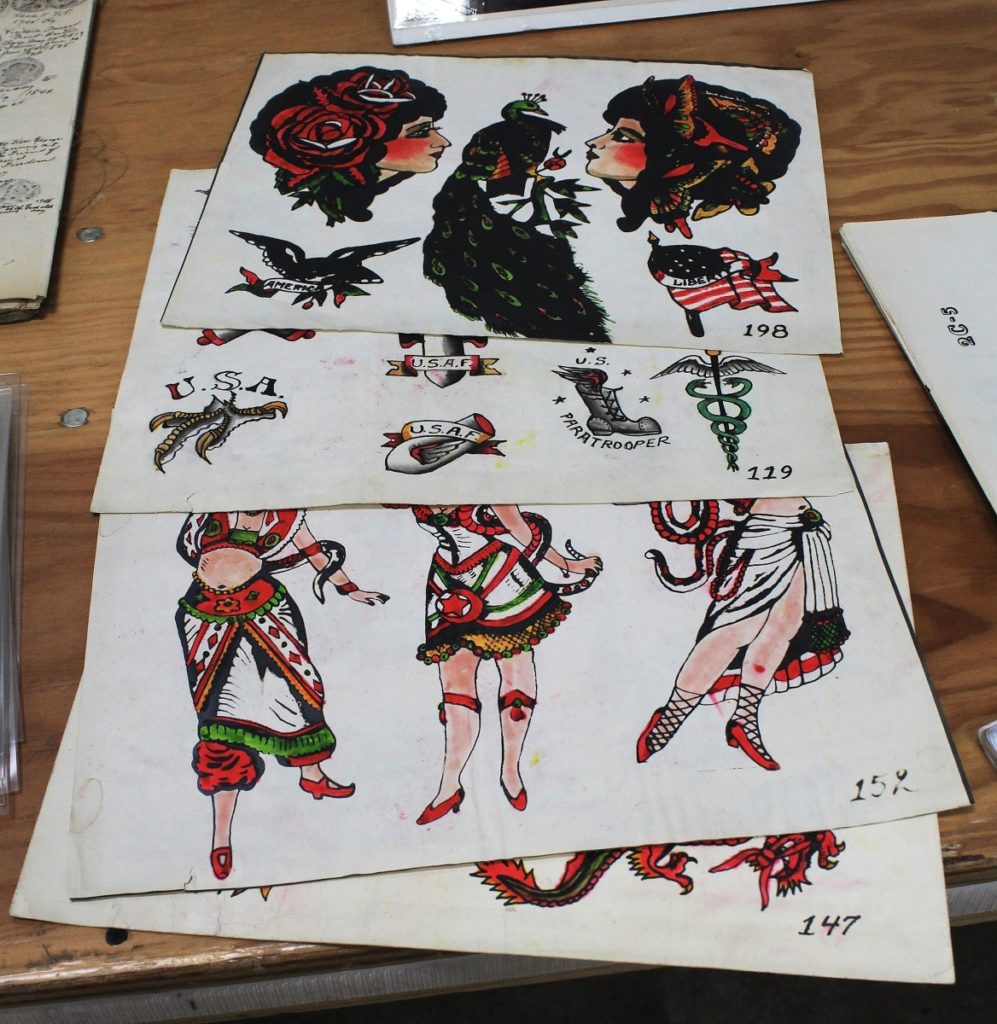
David Winter of Winter Works On Paper, Brooklyn, N.Y., was asking $300 each for these vintage flash sheets, showing original examples of American traditional tattoo art.
One of the rarest treasures at Allentown was in Ken Leininger’s booth, a “juvenile library” made by John Marshall (American, circa 1783-1828). Housed in an attractive slide-top box in the federal style, the number of miniature books that remained in the collection were unprecedented in Leininger’s experience. Marshall began printing these little libraries for children in the 1800s, “galvanizing the children’s book market.” These originally included 16 books and sets of picture-cards. Leininger offered a printed history of the library, which he offered for $2,500.
One never knows who one will meet at a show, and Allentown was no exception. What began as a conversation about a framed antique paper cutout, also known as Scherenschnitte, became a journey into family history. Bruce Updegrove bought the cutout in the 1970s at a Kutztown fair while assisting his father sell his wood carvings. The father was Frank Updegrove, a folk artist known for his highly detailed carvings of life in the early Twentieth Century. Frank was a carpenter by trade and joined the Ringling Bros Barnum & Bailey circus in 1924, when he started to carve naturalistic scenes of circus life and animals. Many of these were housed in a nearby Williamsport, Penn., museum and were sadly destroyed by a fire in 1955. Few examples of his work remain, and some were listed in the 1990 book Just for Nice: Carving and Whittling Magic of Southeastern Pennsylvania. Bruce was proud of his father’s work and had a few framed photographs of a wagon and circus train at his booth.
The spring Allentown Paper Show will be on April 29 and 30, and on October 7 and 8, 2023. For information, contact Sean Klutinoty at 610-573-4969 or www.allentownpapershow.com.

























